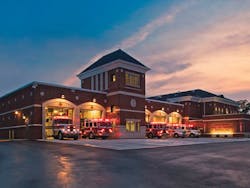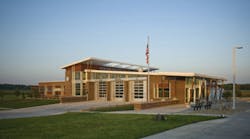Fire Station Design: Building is on the Rebound
I've been hearing a lot of good news from architects who design fire stations. It seems that the decline in new fire stations over the past four years has finally turned around and much needed fire and public safety facilities are on the increase again.
In 2008, when the economy took a nosedive, quite a few fire departments were able to take advantage of lower construction and material costs. However, those bargains didn't last very long and new fire station projects were on hold as municipal budgets were slashed or referendums vetoed. Many architect firms reduced staffing and found increased competition bidding for new projects.
Beginning last fall, however, fire departments were once again pulling out plans and looking for ideas and current trends in new fire stations. Most of the architects that we work with have reported re-hiring staff and putting in longer hours on fire station projects.
Whether this is your first fire station or your 50th, making informed decisions is hard work and can ultimately cost more money, time, political capital and initiative than you'd expect. With today's construction methods, it is fair and reasonable to expect that a new fire station or public safety facility should be built to last 50 to 75 years.
According to Dennis Ross and David Pacheco, Pacheco Ross Architects, most fire departments are blissfully unaware of the often unintended consequences of many of their choices. "Truth be told, in today's fire station landscape, what you believe you know can be just as detrimental to your project as what you don't know," said Ross.
Consequently, "Ignorance isn't bliss" is the title of Ross and Pacheco's opening presentation at the 2014 Station Design Conference, on July 16, in Baltimore, and promises to be a fast-paced, no-holds-barred, sometimes counterintuitive, perhaps controversial presentation.
I've worked with this duo of "hyper-specialized fire station architects" for over 13 years and they have a wealth of experience and information to share. They will educate, offer new perspectives, challenge assumptions, and present actionable, concrete solutions to avoid hidden pitfalls, recognize opportunities, understand architects and much more.
"As we come out of the recession, certain things have stayed the same," said Ross. "Municipalities are desperate and want the same things; 50-75 year buildings that are perfectly designed and able to adapt to all the new technology, that has not changed."
What has changed, according to Ross, is that people are still feeling the effects of the recession and while loosening up the purse strings, services, construction and finished products are no longer at recession-pricing, but have caught up with the new reality.
Ross shared another area that has changed in the northeast. "The process seems to be getting deeper and deeper in regulations--towns, states and counties," he said. "Almost oppressive, approvals are taking a year, even two years. The smaller the municipality, the longer it takes to get through approvals."
Throughout the fire service, the sharing of lessons learned and storytelling has proved to be a valuable method of education. The sooner you start educating yourself about the latest in design and construction of fire stations, the more money, time and frustration you will save.
JANET WILMOTH grew up in a family of firefighters in a suburb of Chicago. Wilmoth, owner of Wilmoth Associates, worked with Fire Chief magazine for 27 years until it closed in 2013. She is currently a Project Director for Firehouse/Cygnus. Wilmoth currently serves on the Board of Directors for the Fire Emergency Manufacturers & Services Association and lives in Lisle, IL.








